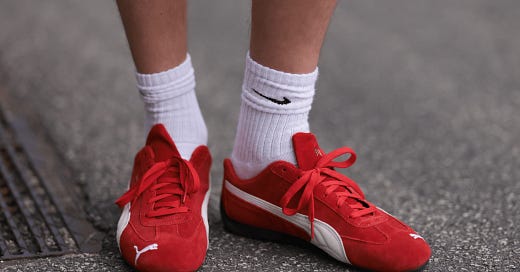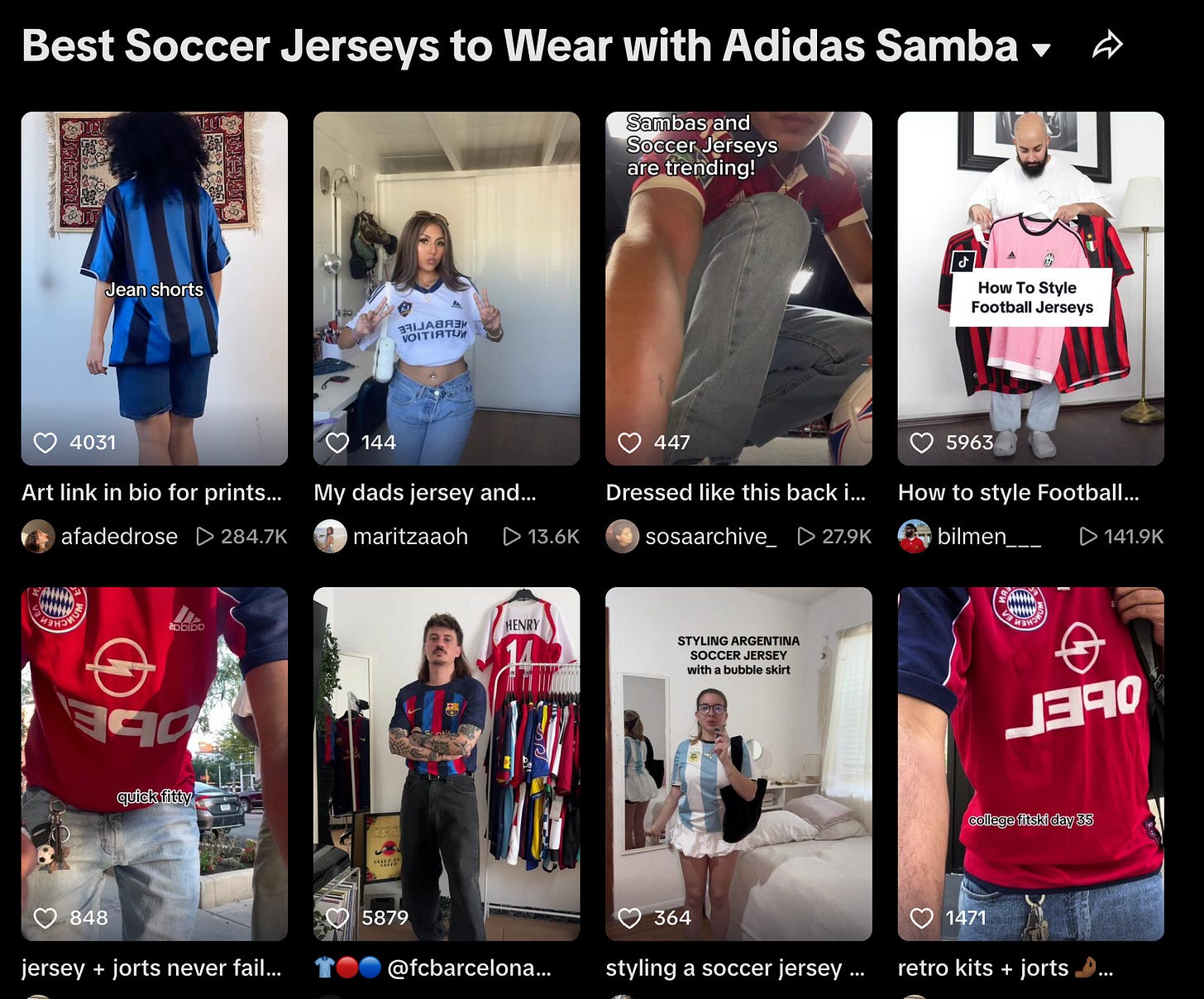How the 'Personal Style' Epidemic Is Impacting Sportswear and Sneakers
Ever since sports-fashion entered the zeitgeist, influential brands have been pushed to chase a turbocharged trend cycle, rather than dictate it.
Hi friends! Welcome back to another edition of SportsVerse, your favourite newsletter at the intersection of sports, fashion, culture and business. Powered by OffBall.
If you’re online at all, you may have been witnessing the growing backlash to the personal style epidemic that has increasingly dominated social media discourse in the fashion world in recent months.
For those uninitiated, the phrase refers to how everyone is desperately seeking to cultivate a unique look and feel to their appearance and fashion sense. Ironically, instead of just going out into the world and working out what colours suit them and what silhouettes match their body type and the vibe they are trying to achieve, these people are taking tips from the same influencers claiming to know the secrets to “finding” your personal style, but who are simply pedalling products from the brands that pay and/or gift them.
The result?
Homogenisation. Everyone is dressing the same way. Everyone is wearing the same brands. Brands are pushing the same aesthetics in their marketing.
The personal style epidemic is not a new concept, nor is this a new take, but what is interesting is how this trend is impacting companies, consumers and creators across the sportswear and sneaker markets.
The impact of the personal style epidemic on this corner of the industry is especially interesting to examine, given how significantly sports and sports-inspired style have entered the wider cultural zeitgeist over the past 18 months.
In a perpetual search to discover “personal style,” consumers’ algorithms provide an ever-narrowing pool of content that introduces them to the very same brands, media channels and products as everyone else simultaenously trying to define their own fashion sense. The dangerous result of this shift is that the trend cycle — the amount of time a product is desirable to mainstream consumers — is becoming shorter than ever before. Once driven by brand power, savvy merchandising strategy and the influence of taste-making retailers, trends are now becoming orchestrated by algorithms which in turn promotes short-term planning on the part of both brands and consumers.
Take the past five years as an example. The popularity of chunky basketball sneakers peaked during the pandemic, and the resale market went crazy. As hype for high-top sneakers began to wane, consumers began quickly gravitating toward gorpcore models like Salomon’s XT-6 silhouette, along with a number of Asics models.
Stores shifted their assortments, sneaker influencers suddenly started pushing the gorpcore “aesthetic”, while every brand out there was trying to get hiking brands on the phone to arrange collaborations to cash in on the trend. But all of a sudden, everyone moved on.
The Adidas Samba came along, seemingly out of nowhere, and all the it-sneaker for the past year became this low profile, low-rise shoe originally designed for German national team football players in the 1950s. Gorpcore was now out — football-inspired “blokecore” style (vomit) was the new kid on the block.
On FYPs and IG feeds, style publications and in stores, the only content consumers were served was fashion tutorials on how to achieve the blokecore look, styling your Adidas Sambas with baggy jorts, a vintage soccer jersey and a luxury brand cardigan or bomber jacket.
The viral hunger to pin our “personal style” around the sneakers and sportswear currently deemed to be in vogue has eaten away at the true nature of what personal style should be — an actual expression of your own personal taste. What’s more, this phenomenon has caused brands — which used to dictate the culture — to re-orient their marketing and merchandising strategies to chase these fleeting and transient trends. Adidas, for example, has an entire sub-section of its website dedicated to “blokecore” products.
It makes sense. It’s designed as a smart SEO hack to catch the millions of people around the world trying to make sense of wtf blokecore is and how to channel that in their everyday style. It makes sense that these companies are following the money. But at the same time it doesn’t sit right — brands that once had the power to show people what was cool and why they should be into it, are now pandering to these fast-moving trends. If they are not careful and over-index too much on one style, they risk getting left exposed with over-supply after the trend cycle has finished its ever-quickening pump and dump process, when the next shiny new thing comes along.
Nike and Puma have also taken note of fashion consumers’ newfound obsession with the football-inspired aesthetic and have launched a string of football-fashion related products and brought back some old school football footwear from their archives in recent months, including the legendary T90 and the Puma King. At Coachella this week, Nike hosted a retro cage-style soccer game with long-time collaborator Travis Scott. Do the clips look cool on Instagram? Sure. Is it authentic to football culture and the transformational role Nike has played in it over the years? Less so.
The same thing is happening with football jerseys and football-related fashion. The item once reserved for the match-going fans is now a fully-fledged fashion staple. Many major teams, fashion brands and their sportswear brand partners are chasing the trend, releasing as many special edition drops and collaborations per season as humanly possible. Kith’s recent work with Adidas has been applauded — and rightfully so. It’s a thoughtful collaboration and great casting with Brazilian legend Kaka. But who is the product for? As a consumer and as a journalist who covers this space, the sheer volume of stuff that these companies put out into the world begins to feel overwhelming.
No previous products or styles are given any time to breathe before they are replaced by the next shiny new thing. Your favourite team is churning out four new jerseys per season. Your favourite streetwear brand is releasing football-inspired jerseys and tracksuits every other week. The creative agency you hired for your new campaign is sending you moodboards with the same retro 1990s kit designs they sent to their last 12 clients.
And everyone — and everything — very quickly begins to look the same.
But if you listen to the internet, football-fashion’s 60 seconds of fame is quickly coming to an end. Next up on the rollercoaster that is the personal style trend cycle? Motorsports.
Fashion has discovered Formula 1, and Formula 1 has discovered fashion. Puma is licking its lips and ramping up production of its racing-inspired Speedcat sneaker, a low-rise shoe that people are claiming will be the “next” Samba.
There’s no conclusion here. Simply that this model of merchandising and consumption is unsustainable. There are not enough people in the world with enough disposable income or wardrobe space or headspace to buy this much product. Brands know this. Retailers know this. Consumers know this.
Maybe, there’s a way forward which allows for a deeper appreciation of the heritage and aesthetic of sport which doesn’t reduce entire cultures into fleeting, oversimplified trends.
Time will tell.
That’s all for today, friends. Thanks for coming along for the ride.
Until next time!
DYM











I've been calling it the Beige Era. From the way they dress, cut their hair, to the way they style their living space. It's copy and paste. It's terrifying. I don't get what brands get to win there if everything looks the same... Why buy your product and not a rival brand or all the dupes? But yeah, it's both annoying, sad, and worrying.
love this article but dear god the number of aesthetics that are being churned out every week is so exhausting ... what happened to the PERSONAL aspect of PERSONAL STYLE? wtf is gorpcore and blokecore and why are brands co opting internet lingo i hate it here